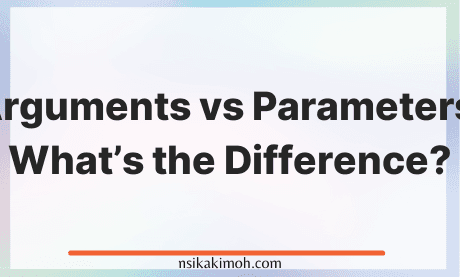Table of Content
- What are Parameters in a Function?
- What are Arguments in a Function?
- What are the Differences Between Arguments and Parameters in a Function?
- Tip to Always Remember the Difference
- Wrap Off
Now and then, I always get stuck wondering about the difference between arguments and parameters whenever I play with functions.
You might also have the same trouble remembering as well. As a matter of fact, some developers think both are the same, whereas others use the terms interchangeably.
Even though most devs will try to infer what you mean, arguments and parameters and not the same, and there are some actual differences.
The concept of arguments and parameters is not language-specific, and rather a notion used for the function definitions in any programming language.
That's the reason for this article, so I can set this in stone and refer to it whenever I am stuck.
In this article, you will learn what arguments and parameters are and the difference when used in a function.
What are Parameters in a Function?
A parameter is a value used in a function during its definition. It acts as a placeholder value within a function.
Parameters define what types of arguments a function can accept.
They represent the values that would be used to achieve a task within a function and in some programming languages, you have to set the type of value that can be passed as an argument to that parameter.
The scope of a parameter is the function itself, and it serves as a local variable inside the function.
For example, given the function definition in Python programming language:
def function_name(param_1, param_2=None, **kwargs):
pass
param_1, param_2, and kwargs are parameters of func.
What are Arguments in a Function?
An argument is the actual value passed to a function when you call the function.
They are the actual values for processing the solution to a problem.
function_name(param_1=23, param_2=34)
The values 23 and 34 are arguments.
The data type of arguments in a function call should match the data type of parameters in the function definition.
Passing the wrong argument to a parameter might cause the program to produce a semantic or syntax error.
Consider the function below, for instance:
def area_of_circle(r, pi=3.143):
return pi * (r**2)
Calling the function using any of the formats below will get the right answer:
area_of_circle(40)
area_of_circle(r=40)
area_of_circle(40, 3.143)
area_of_circle(r=40, pi=3.143)
Calling the function as done in the code below may not get you the right answer, except maybe the value for pi has somehow changed:
area_of_circle(3.143, 40)
What are the Differences Between Arguments and Parameters in a Function?
A parameter is the value used in a function during its definition and acts as a placeholder value within a function, while an argument is the actual value passed to a function when you call the function.
A parameter is optional in some programming languages, and some programming languages allow for a default argument to be provided in a function's declaration. This means that while calling the function, the caller can omit that argument.
A parameter has a name, a data type, and a calling mechanism (call by reference or call by value). In contrast, an argument is an expression that does not have any name, but it can be a variable, a constant, or a literal.
The number of arguments in a function call should match the total number of parameters in the function definition. One exception to this rule is functions with variable-length parameters, such as the *args and **kwargs parameters in Python.
If a parameter is passed by value, modifying it inside the function does not change the corresponding argument in the caller. However, if it is passed by reference, the values of the corresponding argument can be changed in the caller.
Tip to Always Remember the Difference
- PARAMETER → PLACEHOLDER (This means a placeholder belongs to the function naming and be used in the function body)
- ARGUMENT → ACTUAL VALUE (This means an actual value that is passed by the function calling)
Wrap Off
I hope I was able to make the difference clearer.
To review, a parameter is the value used in a function during its definition and acts as a placeholder value within a function, while an argument is the actual value passed to a function when you call the function.
If you learned from this tutorial, or it helped you in any way, please consider sharing and subscribing to our newsletter.
Please share this post and for more insightful posts on business, technology, engineering, history, and marketing, subscribe to our newsletter.
